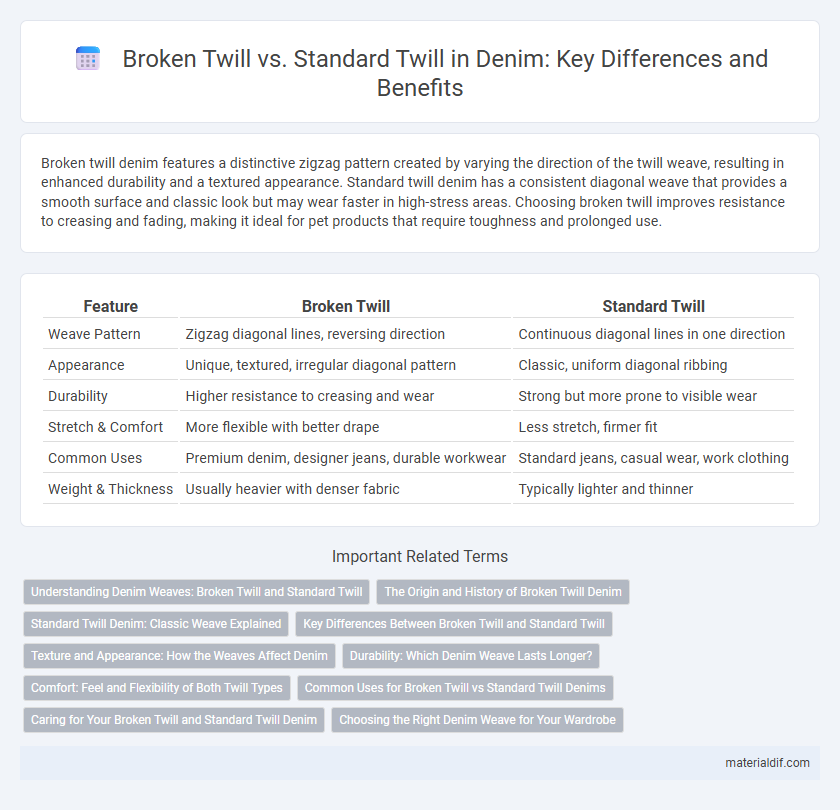Broken twill denim features a distinctive zigzag pattern created by varying the direction of the twill weave, resulting in enhanced durability and a textured appearance. Standard twill denim has a consistent diagonal weave that provides a smooth surface and classic look but may wear faster in high-stress areas. Choosing broken twill improves resistance to creasing and fading, making it ideal for pet products that require toughness and prolonged use.
Table of Comparison
| Feature | Broken Twill | Standard Twill |
|---|---|---|
| Weave Pattern | Zigzag diagonal lines, reversing direction | Continuous diagonal lines in one direction |
| Appearance | Unique, textured, irregular diagonal pattern | Classic, uniform diagonal ribbing |
| Durability | Higher resistance to creasing and wear | Strong but more prone to visible wear |
| Stretch & Comfort | More flexible with better drape | Less stretch, firmer fit |
| Common Uses | Premium denim, designer jeans, durable workwear | Standard jeans, casual wear, work clothing |
| Weight & Thickness | Usually heavier with denser fabric | Typically lighter and thinner |
Understanding Denim Weaves: Broken Twill and Standard Twill
Broken twill denim features irregular diagonal lines that reduce visible twill patterns, enhancing durability and minimizing the risk of fabric twisting. Standard twill denim displays consistent diagonal ribs, creating classic, pronounced lines that contribute to the traditional denim look and feel. Understanding these weave structures helps in selecting denim based on desired texture, appearance, and longevity.
The Origin and History of Broken Twill Denim
Broken twill denim originated as a variation of traditional twill weaving, designed to mimic the look of classic denim while reducing the distinctive diagonal lines found in standard twill. This technique was popularized in the early 20th century by Japanese denim mills aiming to create more textured and durable fabrics with a unique faded appearance. Over time, broken twill has become prized for its ability to produce richer fades and a softer hand, distinguishing it from the more rigid and uniform structure of standard twill denim.
Standard Twill Denim: Classic Weave Explained
Standard twill denim features a diagonal weave pattern that runs uniformly across the fabric, creating a classic, durable texture favored in traditional jeans. This weave enhances strength and resistance to wear, providing a balanced hand feel and a visually consistent grain compared to broken twill's zigzag pattern. The uniform diagonal lines in standard twill contribute to its timeless appearance and reliable performance in denim production.
Key Differences Between Broken Twill and Standard Twill
Broken twill denim features a zigzag weave pattern that disrupts the diagonal line seen in standard twill, providing enhanced durability and reduced fabric distortion over time. Standard twill denim has a consistent diagonal weave that offers a classic look but may show wear patterns more distinctly. The unique weaving technique of broken twill also contributes to a softer texture and improved resistance to creasing compared to standard twill.
Texture and Appearance: How the Weaves Affect Denim
Broken twill denim features an irregular weave pattern that disrupts the traditional diagonal lines, creating a textured surface with a more varied appearance compared to the smooth and consistent diagonal ridges of standard twill denim. This broken weave reduces the chance of pronounced crease lines and fades, resulting in a uniquely distressed look that evolves over time. Standard twill denim maintains a classic, clean diagonal pattern that offers a uniform texture and a sharper, more structured visual appeal.
Durability: Which Denim Weave Lasts Longer?
Broken twill denim features a zigzag pattern that disrupts the traditional diagonal weave found in standard twill, enhancing its resistance to wear and tear. This structure reduces stress points, making broken twill denim more durable and less prone to fading or fraying over time. Standard twill, while strong, tends to show diagonal wear lines more quickly, resulting in less longevity compared to the reinforced, hard-wearing broken twill weave.
Comfort: Feel and Flexibility of Both Twill Types
Broken twill denim features a diagonal weave pattern that reduces stiffness, resulting in enhanced comfort and greater flexibility compared to standard twill. Standard twill denim, with its tight, parallel diagonal weave, offers durability but tends to be less pliable and can feel more rigid on the skin. Wearers seeking softer fabric and improved ease of movement often prefer broken twill for its breathable, smooth texture and relaxed fit.
Common Uses for Broken Twill vs Standard Twill Denims
Broken twill denim, characterized by its irregular diagonal weave pattern, is commonly used in high-end denim jeans and jackets for its enhanced softness and reduced visible wear lines, making it ideal for premium casual wear. Standard twill denim, featuring a consistent diagonal rib pattern, is widely utilized in durable workwear, classic denim jeans, and utility garments due to its strength and traditional rugged appearance. Both weaves serve distinct market needs, with broken twill favored in fashion-forward apparel and standard twill dominating functional and everyday denim products.
Caring for Your Broken Twill and Standard Twill Denim
Caring for broken twill denim requires gentle handling to preserve its diagonal weave texture, avoiding excessive washing that can fade the distinct pattern. Standard twill denim benefits from regular washing in cold water and air drying to maintain its durability and color depth. Both types should be turned inside out before washing to reduce friction and extend the lifespan of the fabric.
Choosing the Right Denim Weave for Your Wardrobe
Broken twill denim features a zigzag pattern that enhances fabric durability and reduces diagonal lines' visibility compared to standard twill's consistent diagonal weave. Standard twill denim offers a classic, smooth diagonal texture prized for its timeless appearance and versatility in casual and formal styles. Selecting between broken and standard twill denim depends on your preference for unique texture and longevity versus a traditional look and consistent wear.
Broken Twill vs Standard Twill Infographic

 materialdif.com
materialdif.com